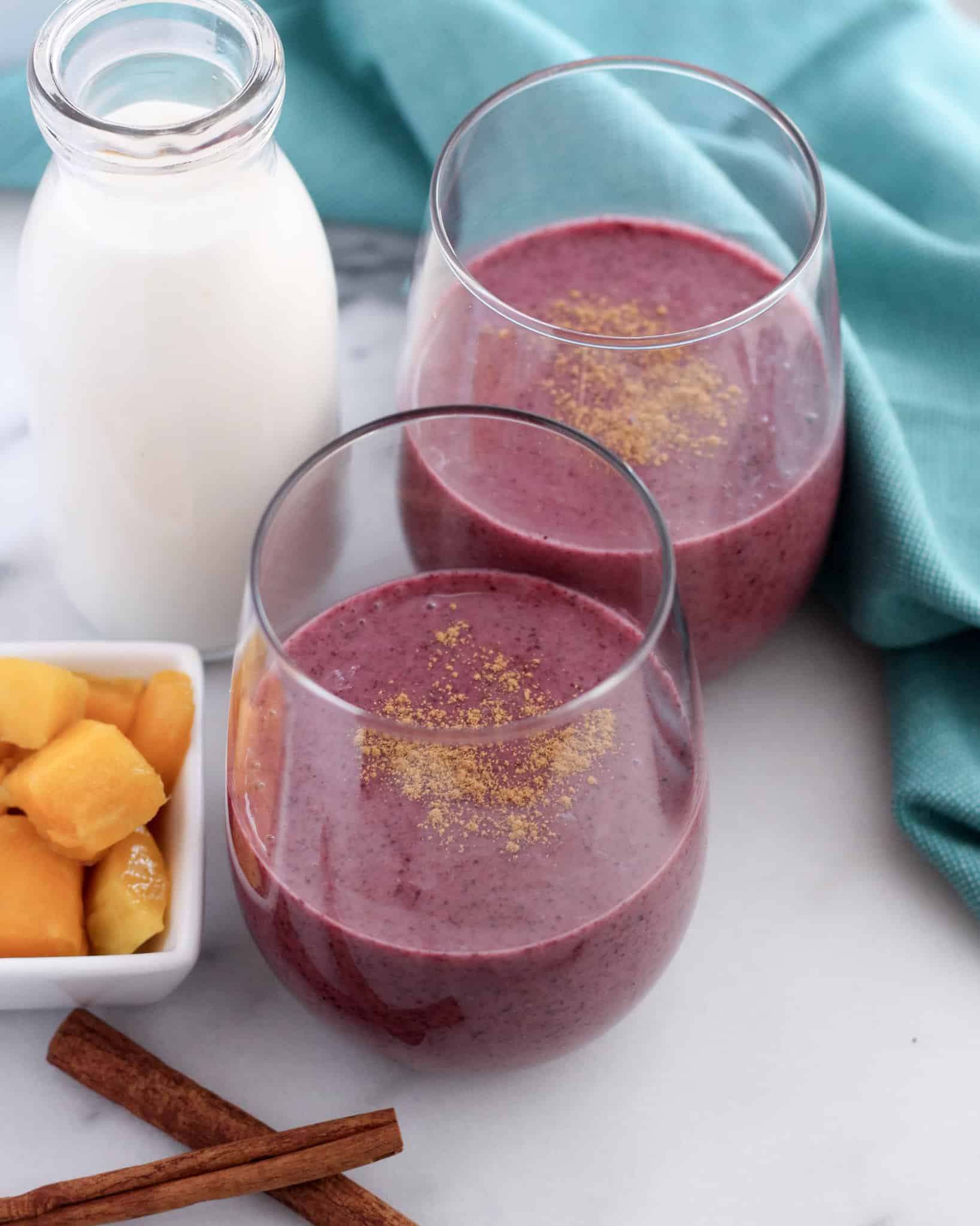Today we’re talking dairy nutrition! Join me to learn more about dairy health benefits and answer some of the most commonly asked questions I get as a registered dietitian about dairy nutrition.
This is part of a four-part series written in partnership with Midwest Dairy. Stay tuned for the rest of the posts in the series where we will explore where dairy comes from and how dairy plays a role in sustainability!
I’ve always had a sweet spot for dairy, going back to my younger years when my uncle and his family became dairy farmers in a small town in Missouri. I didn’t know I was destined to become a registered dietitian at the time, but being in a rural setting and seeing the important work farmers do to feed us every day planted the seeds for my interest in food, where it comes from, and what it means for health.
I’m excited to kick off the “Dive Into Dairy” series with the first of four topics: dairy nutrition! There are many types of dairy foods included in the dairy food group. We’ll take a closer look at some of the dairy health benefits you can enjoy if you include a variety of dairy foods in your meals and snacks!
Dairy Nutrition
The dairy food group includes liquid milk (whole, reduced-fat or 2%, low-fat or 1%, and fat-free or skim), cream (such as the half & half you might add to your coffee), yogurt, cheese, and butter. There are also other forms of dairy that have become popular during the last few years, such as kefir and skyr, two types of a drinkable fermented dairy drink. And, of course, you can’t forget my summer favorite: ice cream!
Let’s get started with a few fast facts about dairy nutrition:
- Dairy foods provide about 54% of the calcium, 56% of the vitamin D, and 18% of the protein consumed by Americans.
- Dairy foods are a source of high-quality protein because they contain essential amino acids our bodies cannot make on their own.
- Milk offers nine essential nutrients, including vitamin A, vitamin D, and calcium and is one of the most affordable sources of these nutrients for many American families.
But as I like to say, people don’t eat individual nutrients – we eat food! There are so many additional dairy health benefits that go beyond dairy nutrition itself.
And speaking of food, you’ll want to check out this roundup of some delicious dairy recipes from fellow dietitians!
What are the health benefits of eating dairy?
Milk and dairy products are certainly not the only food sources of these essential nutrients I already mentioned. But the health benefits of eating dairy are many, and dairy products taste great and are generally easy to find in any grocery store. Dairy foods provide a powerful nutrient package, and here’s what that can mean for overall health:
- Dairy foods are linked to health benefits like reduced inflammation, improved digestive health, and healthy immune systems.
- Healthy eating patterns that include low-fat or fat-free dairy foods are linked to a reduced risk of Type 2 Diabetes and cardiovascular disease in adults, as well as improved bone health when consumed with adequate protein.
- Dairy can be a convenient way to fuel an active lifestyle thanks to its combination of protein, carbohydrates, and essential nutrients.
If you’re trying a smoothie recipe using milk, yogurt, or kefir (like the one pictured below) read my tips on how to makes your smoothies taste better!
Dairy for Active Lifestyles
In some ways, you can think of dairy as a one-stop-shop for athletes and active people. Optimal recovery relies on three things: refueling, rehydrating, and rebuilding before your next workout or training session. The nutrients in dairy can support all three, especially when enjoyed in combination with other foods and food groups. It’s just one more of the dairy health benefits I love!
But don’t just take my word for it. A 2019 literature review by Dr. Louise Burke and her team found that dairy, compared to sports drinks, enhances muscle protein synthesis after endurance exercise like running or cycling. Dairy contains essential amino acids, plus fluids and electrolytes, that can support recovery and refueling efforts after a workout.
Dr. Burke is a world-renowned sports dietitian, serving Olympic teams from 1996 to 2012. She says, “Having a milk-based drink after training can be a way of combining many or all of these nutrients in quantities that meet a specific recovery goal. It’s not the only choice but it’s the easy and versatile choice.”
But milk isn’t the only option. Dairy foods like individual servings of yogurt or cubed, sliced, or string cheese can be simple snacks to keep on hand. And although I didn’t eat it often as a child, one of my current favorite dairy foods is cottage cheese (especially the whole milk, small curd version). I nearly always have a container in my fridge because it makes for such an easy, protein-rich addition to quick breakfasts, snacks, and smoothies. It sounds odd, but compared to protein powders and other specialty ingredients, it’s a much more affordable option that doesn’t require an online order or an extra trip to the store to purchase!

While the health benefits of eating dairy are convincing enough for me, I get many questions from clients and their families about the potential downsides of dairy. If we’re going to take a closer look at dairy nutrition and the health benefits of dairy, we also need to address two of the most common concerns: inflammation and lactose intolerance.
Dairy and Inflammation
This is a heavily researched area. This gives us the benefit of having a wide variety of studies and research designs to help us understand the relationship between dairy and inflammation.
A recent systematic review (2019) included 16 of these studies. The authors of this review looked at the effects of dairy on inflammation using some of the main markers of inflammation. What did they learn? Well, not only was dairy not contributing to the type of inflammation that causes disease, but it actually showed anti-inflammatory effects in both healthy people and people with existing metabolic abnormalities.
Those same results have been seen in various other publications, including 52 human trials included in this review from 2017. That review found the same link between dairy and anti-inflammatory properties but cited some of the limitations of the research. We should remain open to new data as it becomes available, as well as critical of research design and methodologies. Not all research can be considered high-quality. Additionally, inflammation and its role in chronic disease is a complex topic and can’t be blamed on a single nutrient, food, or food group. Lifestyle factors, genetics, and environment, for example, also contribute to overall health (although the research attempts to control for this as much as possible).
The Bottom Line: Research does not indicate that dairy causes inflammation in people who can tolerate it and are not lactose intolerant.
But speaking of lactose…
What about lactose and lactose intolerance?
Lactose intolerance is challenging because the symptoms can vary from person to person. It’s usually characterized by abdominal pain, bloating/gas, and diarrhea after eating or drinking dairy. When these symptoms are caused by your body’s inability to breakdown lactose (one of the simple carbohydrates in milk and dairy products), you are considered lactose intolerant.
NOTE: These uncomfortable symptoms could be caused by something else – if you suspect dairy is not to blame, it may be time to consult a physician, dietitian, or GI specialist to learn what’s causing your issues.
People are able to tolerate different amounts of lactose and symptoms usually appear in early adulthood. You might think the onset of these symptoms spells the end of your ability to freely enjoy dairy, but that’s not the case. You don’t have to miss out on the great taste or health benefits of dairy. There are several lactose-free cows’ milk options in the dairy case. Lactose-free dairy products offer the same great nutrition but are easy to digest for those with lactose intolerance.
If you’re trying to ease symptoms or learn what your tolerance is for dairy products containing lactose, these strategies may help:
The Bottom Line: It’s up to you whether you want to consume dairy products or not. If your symptoms leave you feeling less than your best, you can still nourish and fuel your body with other foods that are better tolerated.
We could dedicate an entire post solely to the topic of lactose intolerance, so for more information, please visit the Lactose Intolerance Facts Page from the U.S. Dairy and National Dairy Council.
Did you learn any new or surprising information about dairy nutrition?
There are so many health benefits of dairy but I think one of my favorite aspects of including dairy in my diet is the enjoyment and satisfaction factor. As an advocate for intuitive eating, I value this part of eating as much as the nutrition part – it’s not enough to simply feel physically full after eating. Including my favorite dairy foods can upgrade a recipe from bland or boring with minimal effort and maximum payoff!
Stay tuned for the rest of my “Dive Into Dairy” blog series over the coming weeks. We’ll explore where dairy comes from, as well as what dairy farmers are doing to become more sustainable. Finally, we’ll wrap things up in Part Four with an “udder-ly” informative Q&A-style blog post with dairy farmers – I always enjoy talking with farmers and can’t wait to bring this conversation to you!
















